Innovation, Commercialisation, and Business Case: Essence Drinks
VerifiedAdded on 2022/11/25
|15
|5466
|196
Report
AI Summary
This report provides an analysis of innovation and commercialisation strategies within the context of Essence Drinks, a UK-based company founded by Mr. Akshay Kumar. It distinguishes between invention and innovation, explores various types of innovation, and examines the processes required to commercialise innovative ideas. The report delves into the impact of organisational vision, leadership, culture, and teamwork on innovation and commercialisation, highlighting Peter Drucker's seven sources of innovation and the four Ps of innovation (Paradigm, Product, Process, Position). It also discusses the innovation funnel and its role in evaluating and shaping innovative ideas, along with the developments in frugal innovation. Furthermore, the report covers the significance of the commercial funnel, the use of New Product Development (NPD) processes, and the creation of an Innovation Business Case, including methods for obtaining funding. Finally, it addresses the methods available to organisations for developing, retaining, and protecting knowledge and intellectual property, providing an evaluation of these tools within the broader business environment.
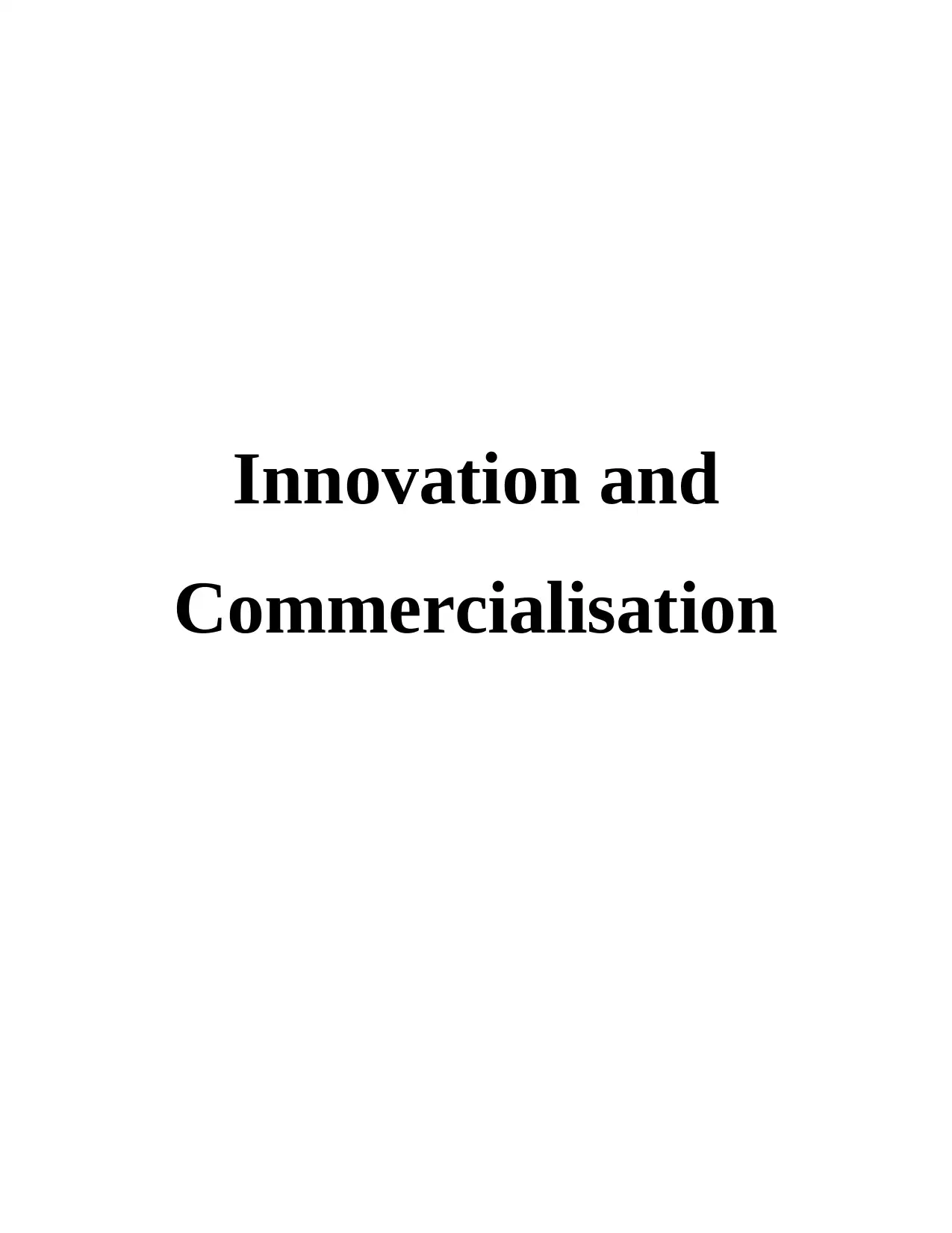
Innovation and
Commercialisation
Commercialisation
Paraphrase This Document
Need a fresh take? Get an instant paraphrase of this document with our AI Paraphraser
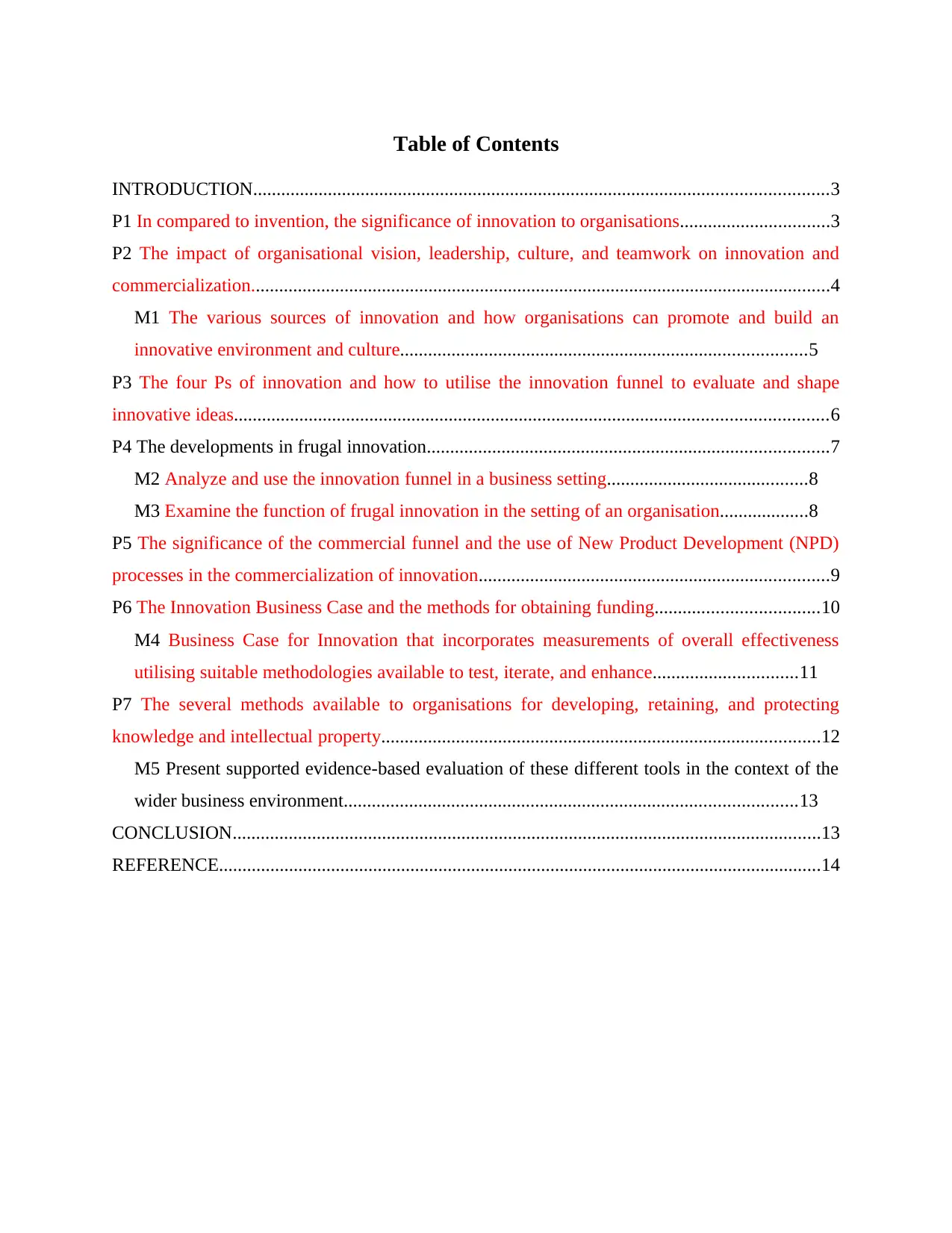
Table of Contents
INTRODUCTION...........................................................................................................................3
P1 In compared to invention, the significance of innovation to organisations................................3
P2 The impact of organisational vision, leadership, culture, and teamwork on innovation and
commercialization............................................................................................................................4
M1 The various sources of innovation and how organisations can promote and build an
innovative environment and culture.......................................................................................5
P3 The four Ps of innovation and how to utilise the innovation funnel to evaluate and shape
innovative ideas...............................................................................................................................6
P4 The developments in frugal innovation......................................................................................7
M2 Analyze and use the innovation funnel in a business setting...........................................8
M3 Examine the function of frugal innovation in the setting of an organisation...................8
P5 The significance of the commercial funnel and the use of New Product Development (NPD)
processes in the commercialization of innovation...........................................................................9
P6 The Innovation Business Case and the methods for obtaining funding...................................10
M4 Business Case for Innovation that incorporates measurements of overall effectiveness
utilising suitable methodologies available to test, iterate, and enhance...............................11
P7 The several methods available to organisations for developing, retaining, and protecting
knowledge and intellectual property..............................................................................................12
M5 Present supported evidence-based evaluation of these different tools in the context of the
wider business environment.................................................................................................13
CONCLUSION..............................................................................................................................13
REFERENCE.................................................................................................................................14
INTRODUCTION...........................................................................................................................3
P1 In compared to invention, the significance of innovation to organisations................................3
P2 The impact of organisational vision, leadership, culture, and teamwork on innovation and
commercialization............................................................................................................................4
M1 The various sources of innovation and how organisations can promote and build an
innovative environment and culture.......................................................................................5
P3 The four Ps of innovation and how to utilise the innovation funnel to evaluate and shape
innovative ideas...............................................................................................................................6
P4 The developments in frugal innovation......................................................................................7
M2 Analyze and use the innovation funnel in a business setting...........................................8
M3 Examine the function of frugal innovation in the setting of an organisation...................8
P5 The significance of the commercial funnel and the use of New Product Development (NPD)
processes in the commercialization of innovation...........................................................................9
P6 The Innovation Business Case and the methods for obtaining funding...................................10
M4 Business Case for Innovation that incorporates measurements of overall effectiveness
utilising suitable methodologies available to test, iterate, and enhance...............................11
P7 The several methods available to organisations for developing, retaining, and protecting
knowledge and intellectual property..............................................................................................12
M5 Present supported evidence-based evaluation of these different tools in the context of the
wider business environment.................................................................................................13
CONCLUSION..............................................................................................................................13
REFERENCE.................................................................................................................................14
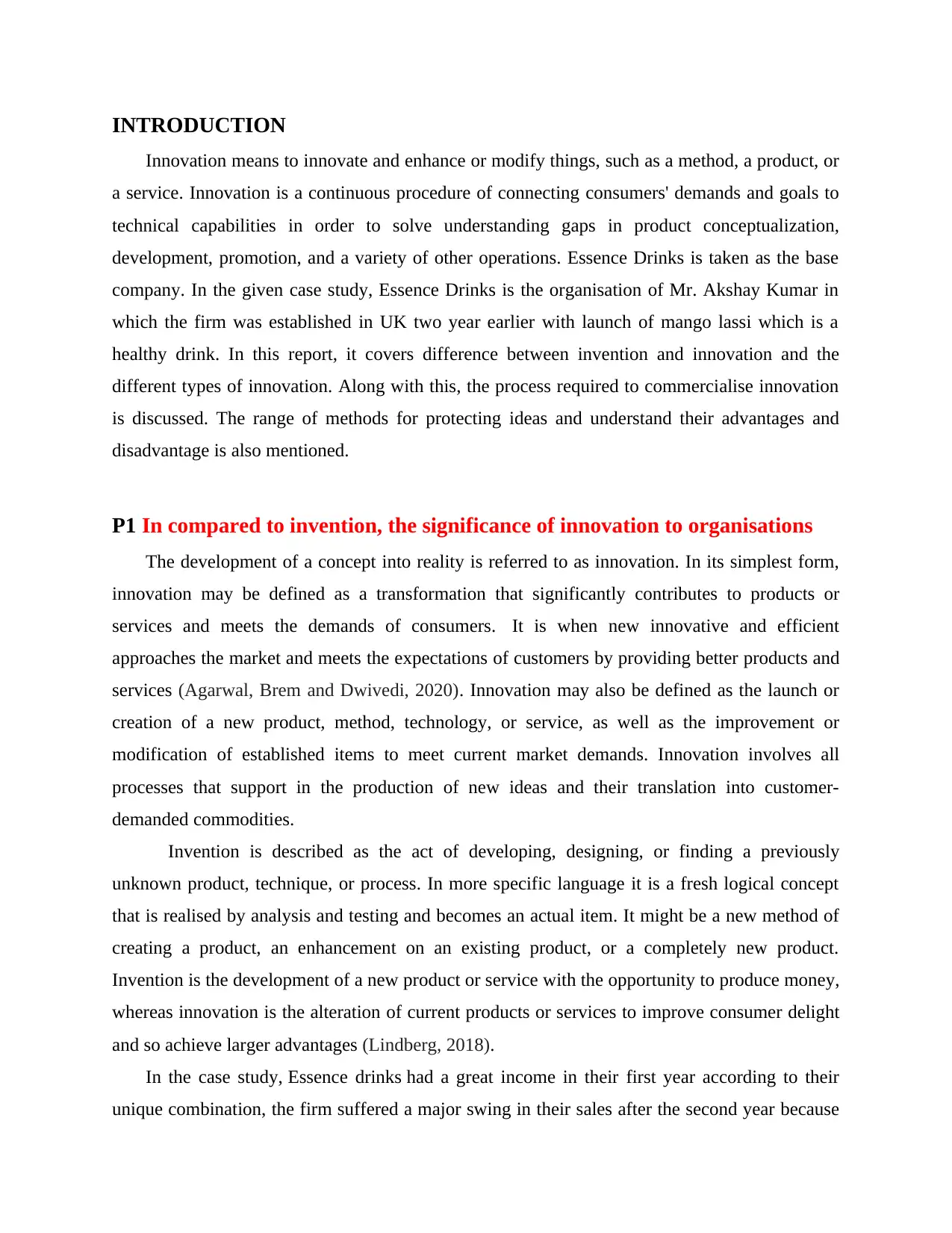
INTRODUCTION
Innovation means to innovate and enhance or modify things, such as a method, a product, or
a service. Innovation is a continuous procedure of connecting consumers' demands and goals to
technical capabilities in order to solve understanding gaps in product conceptualization,
development, promotion, and a variety of other operations. Essence Drinks is taken as the base
company. In the given case study, Essence Drinks is the organisation of Mr. Akshay Kumar in
which the firm was established in UK two year earlier with launch of mango lassi which is a
healthy drink. In this report, it covers difference between invention and innovation and the
different types of innovation. Along with this, the process required to commercialise innovation
is discussed. The range of methods for protecting ideas and understand their advantages and
disadvantage is also mentioned.
P1 In compared to invention, the significance of innovation to organisations
The development of a concept into reality is referred to as innovation. In its simplest form,
innovation may be defined as a transformation that significantly contributes to products or
services and meets the demands of consumers. It is when new innovative and efficient
approaches the market and meets the expectations of customers by providing better products and
services (Agarwal, Brem and Dwivedi, 2020). Innovation may also be defined as the launch or
creation of a new product, method, technology, or service, as well as the improvement or
modification of established items to meet current market demands. Innovation involves all
processes that support in the production of new ideas and their translation into customer-
demanded commodities.
Invention is described as the act of developing, designing, or finding a previously
unknown product, technique, or process. In more specific language it is a fresh logical concept
that is realised by analysis and testing and becomes an actual item. It might be a new method of
creating a product, an enhancement on an existing product, or a completely new product.
Invention is the development of a new product or service with the opportunity to produce money,
whereas innovation is the alteration of current products or services to improve consumer delight
and so achieve larger advantages (Lindberg, 2018).
In the case study, Essence drinks had a great income in their first year according to their
unique combination, the firm suffered a major swing in their sales after the second year because
Innovation means to innovate and enhance or modify things, such as a method, a product, or
a service. Innovation is a continuous procedure of connecting consumers' demands and goals to
technical capabilities in order to solve understanding gaps in product conceptualization,
development, promotion, and a variety of other operations. Essence Drinks is taken as the base
company. In the given case study, Essence Drinks is the organisation of Mr. Akshay Kumar in
which the firm was established in UK two year earlier with launch of mango lassi which is a
healthy drink. In this report, it covers difference between invention and innovation and the
different types of innovation. Along with this, the process required to commercialise innovation
is discussed. The range of methods for protecting ideas and understand their advantages and
disadvantage is also mentioned.
P1 In compared to invention, the significance of innovation to organisations
The development of a concept into reality is referred to as innovation. In its simplest form,
innovation may be defined as a transformation that significantly contributes to products or
services and meets the demands of consumers. It is when new innovative and efficient
approaches the market and meets the expectations of customers by providing better products and
services (Agarwal, Brem and Dwivedi, 2020). Innovation may also be defined as the launch or
creation of a new product, method, technology, or service, as well as the improvement or
modification of established items to meet current market demands. Innovation involves all
processes that support in the production of new ideas and their translation into customer-
demanded commodities.
Invention is described as the act of developing, designing, or finding a previously
unknown product, technique, or process. In more specific language it is a fresh logical concept
that is realised by analysis and testing and becomes an actual item. It might be a new method of
creating a product, an enhancement on an existing product, or a completely new product.
Invention is the development of a new product or service with the opportunity to produce money,
whereas innovation is the alteration of current products or services to improve consumer delight
and so achieve larger advantages (Lindberg, 2018).
In the case study, Essence drinks had a great income in their first year according to their
unique combination, the firm suffered a major swing in their sales after the second year because
⊘ This is a preview!⊘
Do you want full access?
Subscribe today to unlock all pages.

Trusted by 1+ million students worldwide
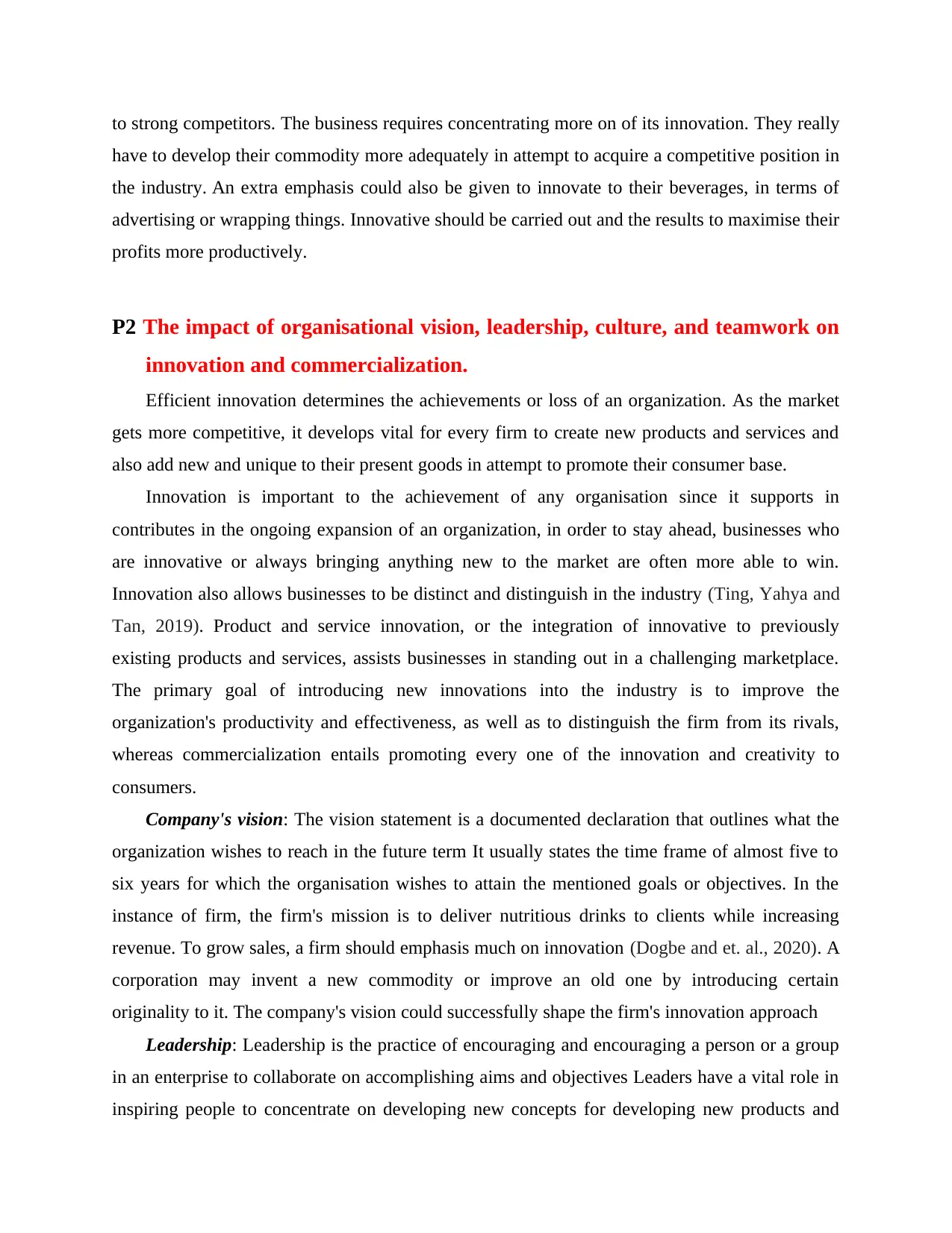
to strong competitors. The business requires concentrating more on of its innovation. They really
have to develop their commodity more adequately in attempt to acquire a competitive position in
the industry. An extra emphasis could also be given to innovate to their beverages, in terms of
advertising or wrapping things. Innovative should be carried out and the results to maximise their
profits more productively.
P2 The impact of organisational vision, leadership, culture, and teamwork on
innovation and commercialization.
Efficient innovation determines the achievements or loss of an organization. As the market
gets more competitive, it develops vital for every firm to create new products and services and
also add new and unique to their present goods in attempt to promote their consumer base.
Innovation is important to the achievement of any organisation since it supports in
contributes in the ongoing expansion of an organization, in order to stay ahead, businesses who
are innovative or always bringing anything new to the market are often more able to win.
Innovation also allows businesses to be distinct and distinguish in the industry (Ting, Yahya and
Tan, 2019). Product and service innovation, or the integration of innovative to previously
existing products and services, assists businesses in standing out in a challenging marketplace.
The primary goal of introducing new innovations into the industry is to improve the
organization's productivity and effectiveness, as well as to distinguish the firm from its rivals,
whereas commercialization entails promoting every one of the innovation and creativity to
consumers.
Company's vision: The vision statement is a documented declaration that outlines what the
organization wishes to reach in the future term It usually states the time frame of almost five to
six years for which the organisation wishes to attain the mentioned goals or objectives. In the
instance of firm, the firm's mission is to deliver nutritious drinks to clients while increasing
revenue. To grow sales, a firm should emphasis much on innovation (Dogbe and et. al., 2020). A
corporation may invent a new commodity or improve an old one by introducing certain
originality to it. The company's vision could successfully shape the firm's innovation approach
Leadership: Leadership is the practice of encouraging and encouraging a person or a group
in an enterprise to collaborate on accomplishing aims and objectives Leaders have a vital role in
inspiring people to concentrate on developing new concepts for developing new products and
have to develop their commodity more adequately in attempt to acquire a competitive position in
the industry. An extra emphasis could also be given to innovate to their beverages, in terms of
advertising or wrapping things. Innovative should be carried out and the results to maximise their
profits more productively.
P2 The impact of organisational vision, leadership, culture, and teamwork on
innovation and commercialization.
Efficient innovation determines the achievements or loss of an organization. As the market
gets more competitive, it develops vital for every firm to create new products and services and
also add new and unique to their present goods in attempt to promote their consumer base.
Innovation is important to the achievement of any organisation since it supports in
contributes in the ongoing expansion of an organization, in order to stay ahead, businesses who
are innovative or always bringing anything new to the market are often more able to win.
Innovation also allows businesses to be distinct and distinguish in the industry (Ting, Yahya and
Tan, 2019). Product and service innovation, or the integration of innovative to previously
existing products and services, assists businesses in standing out in a challenging marketplace.
The primary goal of introducing new innovations into the industry is to improve the
organization's productivity and effectiveness, as well as to distinguish the firm from its rivals,
whereas commercialization entails promoting every one of the innovation and creativity to
consumers.
Company's vision: The vision statement is a documented declaration that outlines what the
organization wishes to reach in the future term It usually states the time frame of almost five to
six years for which the organisation wishes to attain the mentioned goals or objectives. In the
instance of firm, the firm's mission is to deliver nutritious drinks to clients while increasing
revenue. To grow sales, a firm should emphasis much on innovation (Dogbe and et. al., 2020). A
corporation may invent a new commodity or improve an old one by introducing certain
originality to it. The company's vision could successfully shape the firm's innovation approach
Leadership: Leadership is the practice of encouraging and encouraging a person or a group
in an enterprise to collaborate on accomplishing aims and objectives Leaders have a vital role in
inspiring people to concentrate on developing new concepts for developing new products and
Paraphrase This Document
Need a fresh take? Get an instant paraphrase of this document with our AI Paraphraser
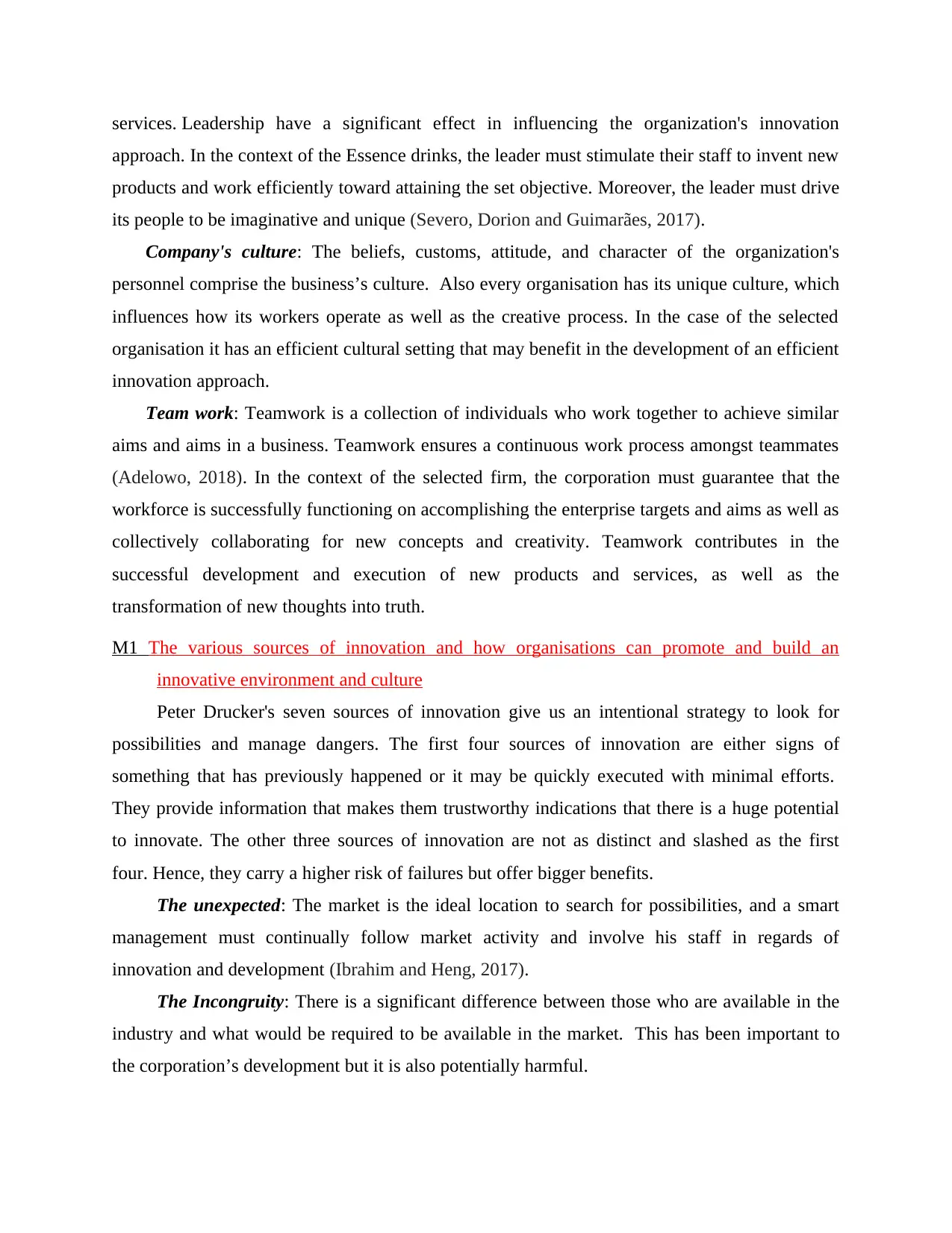
services. Leadership have a significant effect in influencing the organization's innovation
approach. In the context of the Essence drinks, the leader must stimulate their staff to invent new
products and work efficiently toward attaining the set objective. Moreover, the leader must drive
its people to be imaginative and unique (Severo, Dorion and Guimarães, 2017).
Company's culture: The beliefs, customs, attitude, and character of the organization's
personnel comprise the business’s culture. Also every organisation has its unique culture, which
influences how its workers operate as well as the creative process. In the case of the selected
organisation it has an efficient cultural setting that may benefit in the development of an efficient
innovation approach.
Team work: Teamwork is a collection of individuals who work together to achieve similar
aims and aims in a business. Teamwork ensures a continuous work process amongst teammates
(Adelowo, 2018). In the context of the selected firm, the corporation must guarantee that the
workforce is successfully functioning on accomplishing the enterprise targets and aims as well as
collectively collaborating for new concepts and creativity. Teamwork contributes in the
successful development and execution of new products and services, as well as the
transformation of new thoughts into truth.
M1 The various sources of innovation and how organisations can promote and build an
innovative environment and culture
Peter Drucker's seven sources of innovation give us an intentional strategy to look for
possibilities and manage dangers. The first four sources of innovation are either signs of
something that has previously happened or it may be quickly executed with minimal efforts.
They provide information that makes them trustworthy indications that there is a huge potential
to innovate. The other three sources of innovation are not as distinct and slashed as the first
four. Hence, they carry a higher risk of failures but offer bigger benefits.
The unexpected: The market is the ideal location to search for possibilities, and a smart
management must continually follow market activity and involve his staff in regards of
innovation and development (Ibrahim and Heng, 2017).
The Incongruity: There is a significant difference between those who are available in the
industry and what would be required to be available in the market. This has been important to
the corporation’s development but it is also potentially harmful.
approach. In the context of the Essence drinks, the leader must stimulate their staff to invent new
products and work efficiently toward attaining the set objective. Moreover, the leader must drive
its people to be imaginative and unique (Severo, Dorion and Guimarães, 2017).
Company's culture: The beliefs, customs, attitude, and character of the organization's
personnel comprise the business’s culture. Also every organisation has its unique culture, which
influences how its workers operate as well as the creative process. In the case of the selected
organisation it has an efficient cultural setting that may benefit in the development of an efficient
innovation approach.
Team work: Teamwork is a collection of individuals who work together to achieve similar
aims and aims in a business. Teamwork ensures a continuous work process amongst teammates
(Adelowo, 2018). In the context of the selected firm, the corporation must guarantee that the
workforce is successfully functioning on accomplishing the enterprise targets and aims as well as
collectively collaborating for new concepts and creativity. Teamwork contributes in the
successful development and execution of new products and services, as well as the
transformation of new thoughts into truth.
M1 The various sources of innovation and how organisations can promote and build an
innovative environment and culture
Peter Drucker's seven sources of innovation give us an intentional strategy to look for
possibilities and manage dangers. The first four sources of innovation are either signs of
something that has previously happened or it may be quickly executed with minimal efforts.
They provide information that makes them trustworthy indications that there is a huge potential
to innovate. The other three sources of innovation are not as distinct and slashed as the first
four. Hence, they carry a higher risk of failures but offer bigger benefits.
The unexpected: The market is the ideal location to search for possibilities, and a smart
management must continually follow market activity and involve his staff in regards of
innovation and development (Ibrahim and Heng, 2017).
The Incongruity: There is a significant difference between those who are available in the
industry and what would be required to be available in the market. This has been important to
the corporation’s development but it is also potentially harmful.
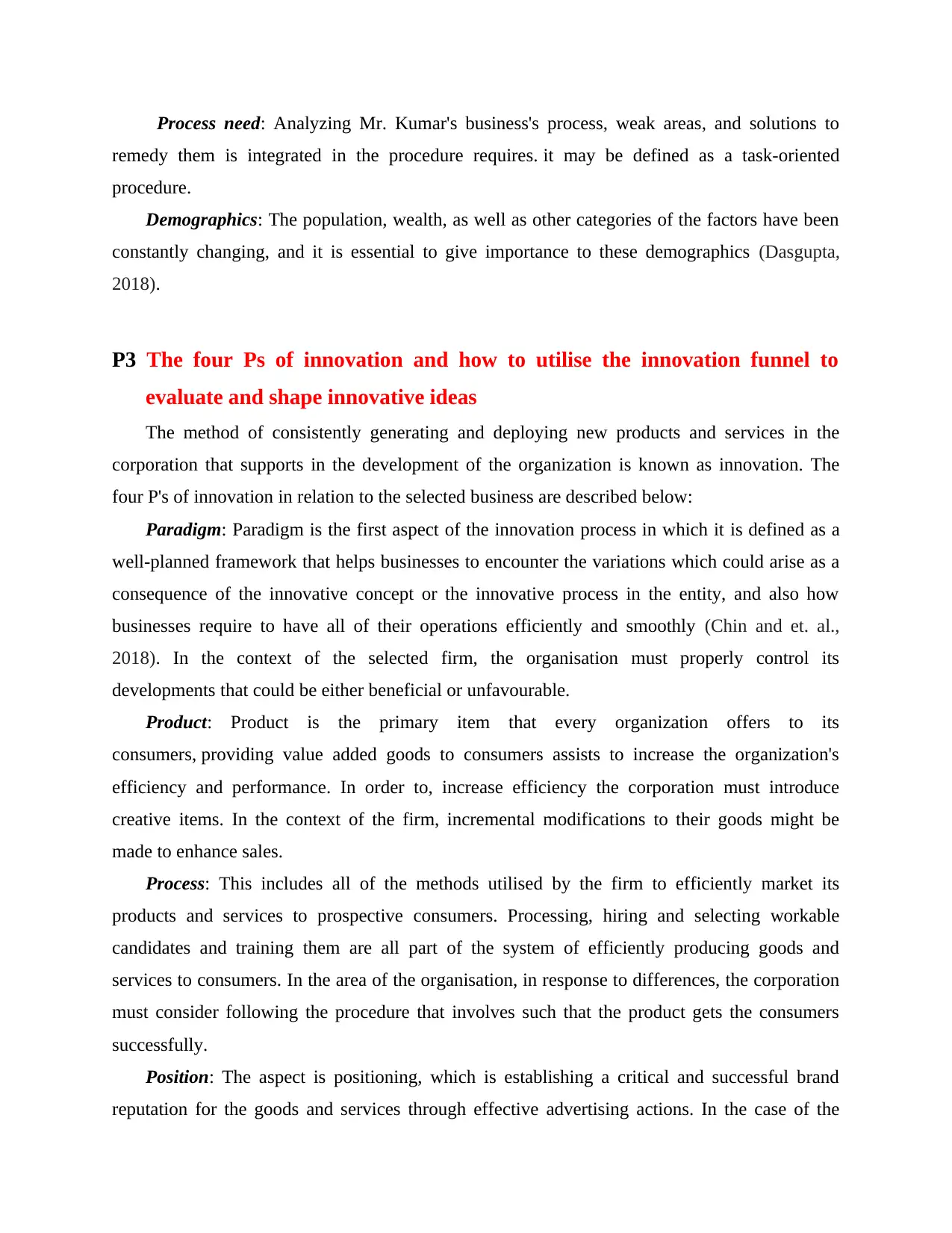
Process need: Analyzing Mr. Kumar's business's process, weak areas, and solutions to
remedy them is integrated in the procedure requires. it may be defined as a task-oriented
procedure.
Demographics: The population, wealth, as well as other categories of the factors have been
constantly changing, and it is essential to give importance to these demographics (Dasgupta,
2018).
P3 The four Ps of innovation and how to utilise the innovation funnel to
evaluate and shape innovative ideas
The method of consistently generating and deploying new products and services in the
corporation that supports in the development of the organization is known as innovation. The
four P's of innovation in relation to the selected business are described below:
Paradigm: Paradigm is the first aspect of the innovation process in which it is defined as a
well-planned framework that helps businesses to encounter the variations which could arise as a
consequence of the innovative concept or the innovative process in the entity, and also how
businesses require to have all of their operations efficiently and smoothly (Chin and et. al.,
2018). In the context of the selected firm, the organisation must properly control its
developments that could be either beneficial or unfavourable.
Product: Product is the primary item that every organization offers to its
consumers, providing value added goods to consumers assists to increase the organization's
efficiency and performance. In order to, increase efficiency the corporation must introduce
creative items. In the context of the firm, incremental modifications to their goods might be
made to enhance sales.
Process: This includes all of the methods utilised by the firm to efficiently market its
products and services to prospective consumers. Processing, hiring and selecting workable
candidates and training them are all part of the system of efficiently producing goods and
services to consumers. In the area of the organisation, in response to differences, the corporation
must consider following the procedure that involves such that the product gets the consumers
successfully.
Position: The aspect is positioning, which is establishing a critical and successful brand
reputation for the goods and services through effective advertising actions. In the case of the
remedy them is integrated in the procedure requires. it may be defined as a task-oriented
procedure.
Demographics: The population, wealth, as well as other categories of the factors have been
constantly changing, and it is essential to give importance to these demographics (Dasgupta,
2018).
P3 The four Ps of innovation and how to utilise the innovation funnel to
evaluate and shape innovative ideas
The method of consistently generating and deploying new products and services in the
corporation that supports in the development of the organization is known as innovation. The
four P's of innovation in relation to the selected business are described below:
Paradigm: Paradigm is the first aspect of the innovation process in which it is defined as a
well-planned framework that helps businesses to encounter the variations which could arise as a
consequence of the innovative concept or the innovative process in the entity, and also how
businesses require to have all of their operations efficiently and smoothly (Chin and et. al.,
2018). In the context of the selected firm, the organisation must properly control its
developments that could be either beneficial or unfavourable.
Product: Product is the primary item that every organization offers to its
consumers, providing value added goods to consumers assists to increase the organization's
efficiency and performance. In order to, increase efficiency the corporation must introduce
creative items. In the context of the firm, incremental modifications to their goods might be
made to enhance sales.
Process: This includes all of the methods utilised by the firm to efficiently market its
products and services to prospective consumers. Processing, hiring and selecting workable
candidates and training them are all part of the system of efficiently producing goods and
services to consumers. In the area of the organisation, in response to differences, the corporation
must consider following the procedure that involves such that the product gets the consumers
successfully.
Position: The aspect is positioning, which is establishing a critical and successful brand
reputation for the goods and services through effective advertising actions. In the case of the
⊘ This is a preview!⊘
Do you want full access?
Subscribe today to unlock all pages.

Trusted by 1+ million students worldwide
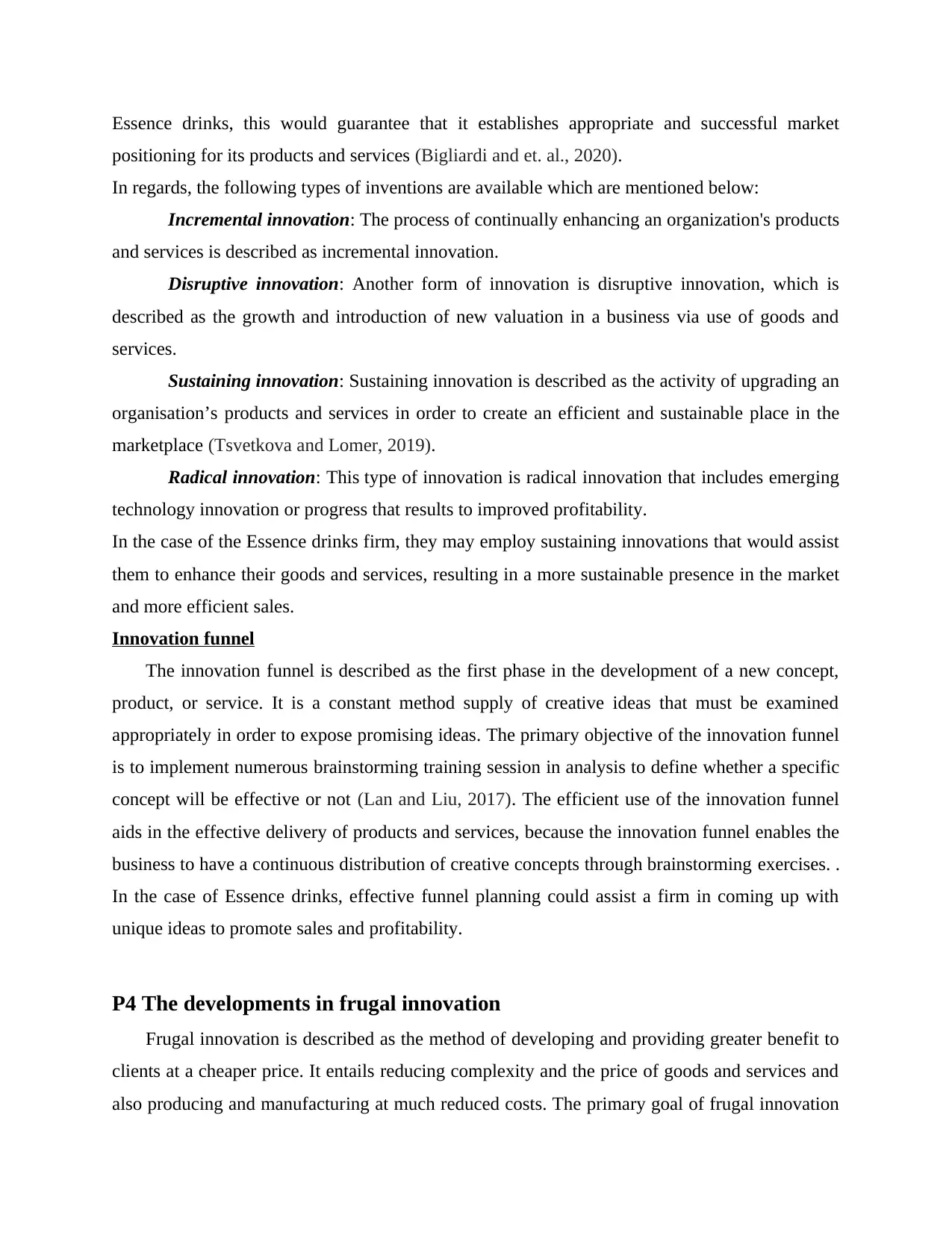
Essence drinks, this would guarantee that it establishes appropriate and successful market
positioning for its products and services (Bigliardi and et. al., 2020).
In regards, the following types of inventions are available which are mentioned below:
Incremental innovation: The process of continually enhancing an organization's products
and services is described as incremental innovation.
Disruptive innovation: Another form of innovation is disruptive innovation, which is
described as the growth and introduction of new valuation in a business via use of goods and
services.
Sustaining innovation: Sustaining innovation is described as the activity of upgrading an
organisation’s products and services in order to create an efficient and sustainable place in the
marketplace (Tsvetkova and Lomer, 2019).
Radical innovation: This type of innovation is radical innovation that includes emerging
technology innovation or progress that results to improved profitability.
In the case of the Essence drinks firm, they may employ sustaining innovations that would assist
them to enhance their goods and services, resulting in a more sustainable presence in the market
and more efficient sales.
Innovation funnel
The innovation funnel is described as the first phase in the development of a new concept,
product, or service. It is a constant method supply of creative ideas that must be examined
appropriately in order to expose promising ideas. The primary objective of the innovation funnel
is to implement numerous brainstorming training session in analysis to define whether a specific
concept will be effective or not (Lan and Liu, 2017). The efficient use of the innovation funnel
aids in the effective delivery of products and services, because the innovation funnel enables the
business to have a continuous distribution of creative concepts through brainstorming exercises. .
In the case of Essence drinks, effective funnel planning could assist a firm in coming up with
unique ideas to promote sales and profitability.
P4 The developments in frugal innovation
Frugal innovation is described as the method of developing and providing greater benefit to
clients at a cheaper price. It entails reducing complexity and the price of goods and services and
also producing and manufacturing at much reduced costs. The primary goal of frugal innovation
positioning for its products and services (Bigliardi and et. al., 2020).
In regards, the following types of inventions are available which are mentioned below:
Incremental innovation: The process of continually enhancing an organization's products
and services is described as incremental innovation.
Disruptive innovation: Another form of innovation is disruptive innovation, which is
described as the growth and introduction of new valuation in a business via use of goods and
services.
Sustaining innovation: Sustaining innovation is described as the activity of upgrading an
organisation’s products and services in order to create an efficient and sustainable place in the
marketplace (Tsvetkova and Lomer, 2019).
Radical innovation: This type of innovation is radical innovation that includes emerging
technology innovation or progress that results to improved profitability.
In the case of the Essence drinks firm, they may employ sustaining innovations that would assist
them to enhance their goods and services, resulting in a more sustainable presence in the market
and more efficient sales.
Innovation funnel
The innovation funnel is described as the first phase in the development of a new concept,
product, or service. It is a constant method supply of creative ideas that must be examined
appropriately in order to expose promising ideas. The primary objective of the innovation funnel
is to implement numerous brainstorming training session in analysis to define whether a specific
concept will be effective or not (Lan and Liu, 2017). The efficient use of the innovation funnel
aids in the effective delivery of products and services, because the innovation funnel enables the
business to have a continuous distribution of creative concepts through brainstorming exercises. .
In the case of Essence drinks, effective funnel planning could assist a firm in coming up with
unique ideas to promote sales and profitability.
P4 The developments in frugal innovation
Frugal innovation is described as the method of developing and providing greater benefit to
clients at a cheaper price. It entails reducing complexity and the price of goods and services and
also producing and manufacturing at much reduced costs. The primary goal of frugal innovation
Paraphrase This Document
Need a fresh take? Get an instant paraphrase of this document with our AI Paraphraser
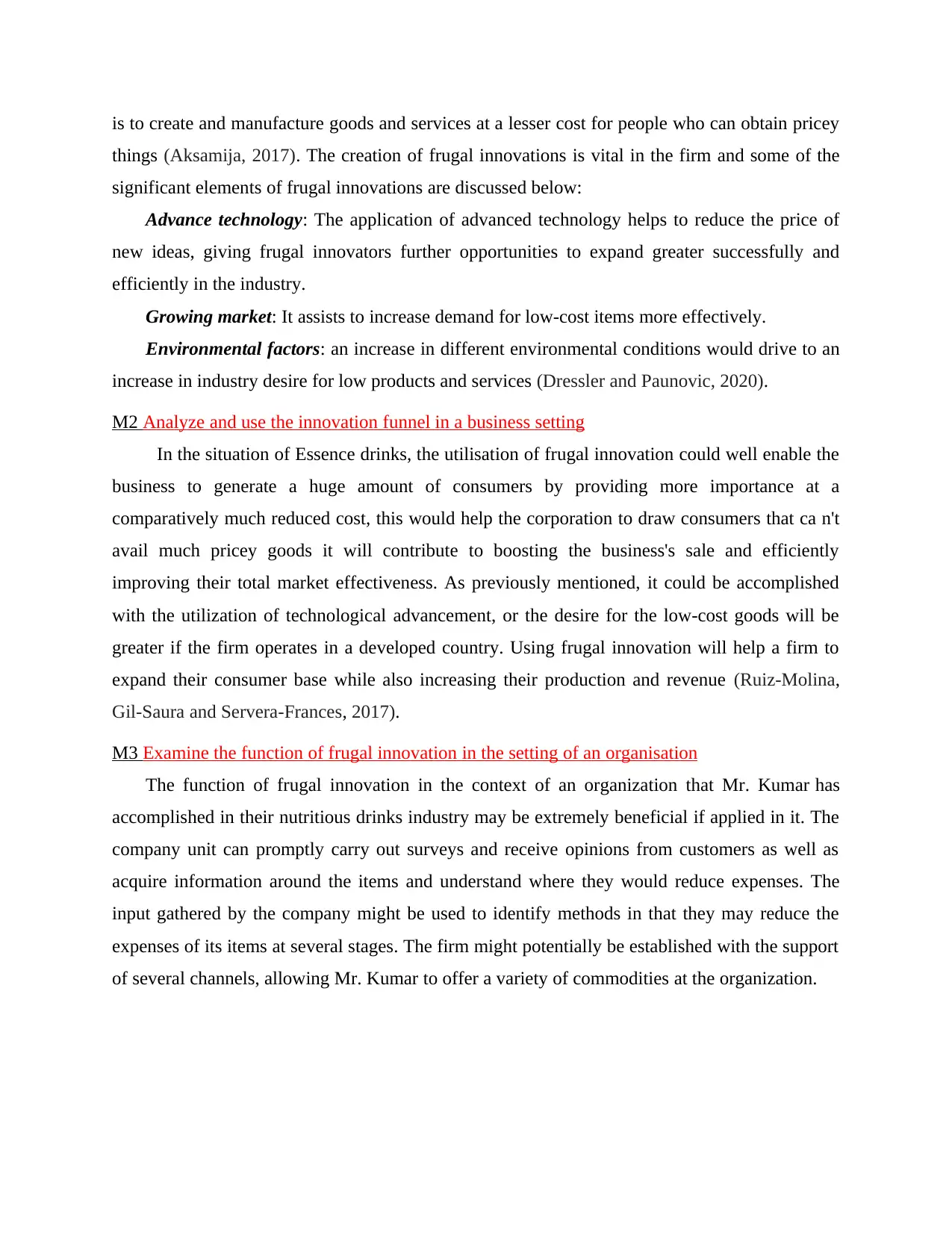
is to create and manufacture goods and services at a lesser cost for people who can obtain pricey
things (Aksamija, 2017). The creation of frugal innovations is vital in the firm and some of the
significant elements of frugal innovations are discussed below:
Advance technology: The application of advanced technology helps to reduce the price of
new ideas, giving frugal innovators further opportunities to expand greater successfully and
efficiently in the industry.
Growing market: It assists to increase demand for low-cost items more effectively.
Environmental factors: an increase in different environmental conditions would drive to an
increase in industry desire for low products and services (Dressler and Paunovic, 2020).
M2 Analyze and use the innovation funnel in a business setting
In the situation of Essence drinks, the utilisation of frugal innovation could well enable the
business to generate a huge amount of consumers by providing more importance at a
comparatively much reduced cost, this would help the corporation to draw consumers that ca n't
avail much pricey goods it will contribute to boosting the business's sale and efficiently
improving their total market effectiveness. As previously mentioned, it could be accomplished
with the utilization of technological advancement, or the desire for the low-cost goods will be
greater if the firm operates in a developed country. Using frugal innovation will help a firm to
expand their consumer base while also increasing their production and revenue (Ruiz-Molina,
Gil-Saura and Servera-Frances, 2017).
M3 Examine the function of frugal innovation in the setting of an organisation
The function of frugal innovation in the context of an organization that Mr. Kumar has
accomplished in their nutritious drinks industry may be extremely beneficial if applied in it. The
company unit can promptly carry out surveys and receive opinions from customers as well as
acquire information around the items and understand where they would reduce expenses. The
input gathered by the company might be used to identify methods in that they may reduce the
expenses of its items at several stages. The firm might potentially be established with the support
of several channels, allowing Mr. Kumar to offer a variety of commodities at the organization.
things (Aksamija, 2017). The creation of frugal innovations is vital in the firm and some of the
significant elements of frugal innovations are discussed below:
Advance technology: The application of advanced technology helps to reduce the price of
new ideas, giving frugal innovators further opportunities to expand greater successfully and
efficiently in the industry.
Growing market: It assists to increase demand for low-cost items more effectively.
Environmental factors: an increase in different environmental conditions would drive to an
increase in industry desire for low products and services (Dressler and Paunovic, 2020).
M2 Analyze and use the innovation funnel in a business setting
In the situation of Essence drinks, the utilisation of frugal innovation could well enable the
business to generate a huge amount of consumers by providing more importance at a
comparatively much reduced cost, this would help the corporation to draw consumers that ca n't
avail much pricey goods it will contribute to boosting the business's sale and efficiently
improving their total market effectiveness. As previously mentioned, it could be accomplished
with the utilization of technological advancement, or the desire for the low-cost goods will be
greater if the firm operates in a developed country. Using frugal innovation will help a firm to
expand their consumer base while also increasing their production and revenue (Ruiz-Molina,
Gil-Saura and Servera-Frances, 2017).
M3 Examine the function of frugal innovation in the setting of an organisation
The function of frugal innovation in the context of an organization that Mr. Kumar has
accomplished in their nutritious drinks industry may be extremely beneficial if applied in it. The
company unit can promptly carry out surveys and receive opinions from customers as well as
acquire information around the items and understand where they would reduce expenses. The
input gathered by the company might be used to identify methods in that they may reduce the
expenses of its items at several stages. The firm might potentially be established with the support
of several channels, allowing Mr. Kumar to offer a variety of commodities at the organization.
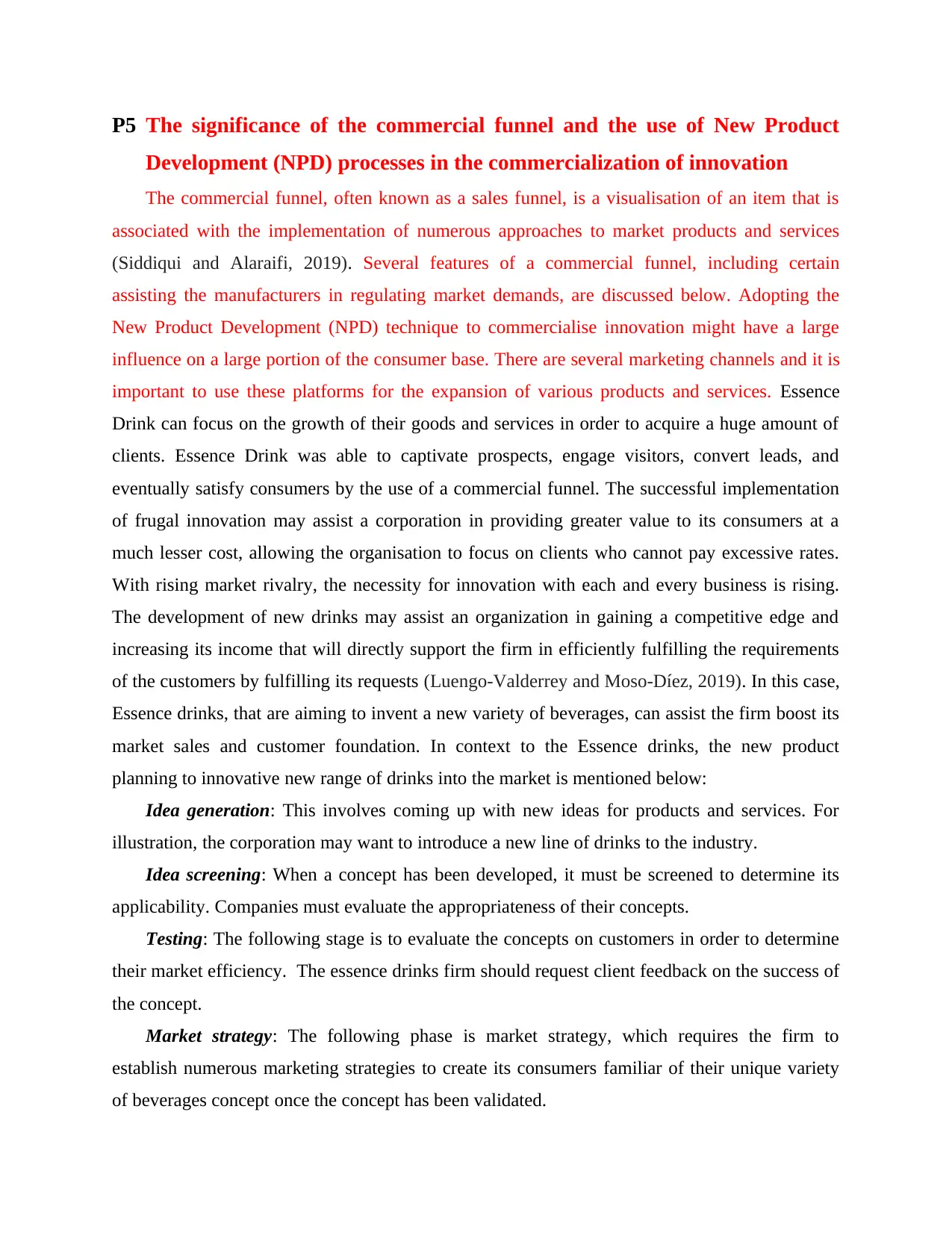
P5 The significance of the commercial funnel and the use of New Product
Development (NPD) processes in the commercialization of innovation
The commercial funnel, often known as a sales funnel, is a visualisation of an item that is
associated with the implementation of numerous approaches to market products and services
(Siddiqui and Alaraifi, 2019). Several features of a commercial funnel, including certain
assisting the manufacturers in regulating market demands, are discussed below. Adopting the
New Product Development (NPD) technique to commercialise innovation might have a large
influence on a large portion of the consumer base. There are several marketing channels and it is
important to use these platforms for the expansion of various products and services. Essence
Drink can focus on the growth of their goods and services in order to acquire a huge amount of
clients. Essence Drink was able to captivate prospects, engage visitors, convert leads, and
eventually satisfy consumers by the use of a commercial funnel. The successful implementation
of frugal innovation may assist a corporation in providing greater value to its consumers at a
much lesser cost, allowing the organisation to focus on clients who cannot pay excessive rates.
With rising market rivalry, the necessity for innovation with each and every business is rising.
The development of new drinks may assist an organization in gaining a competitive edge and
increasing its income that will directly support the firm in efficiently fulfilling the requirements
of the customers by fulfilling its requests (Luengo-Valderrey and Moso-Díez, 2019). In this case,
Essence drinks, that are aiming to invent a new variety of beverages, can assist the firm boost its
market sales and customer foundation. In context to the Essence drinks, the new product
planning to innovative new range of drinks into the market is mentioned below:
Idea generation: This involves coming up with new ideas for products and services. For
illustration, the corporation may want to introduce a new line of drinks to the industry.
Idea screening: When a concept has been developed, it must be screened to determine its
applicability. Companies must evaluate the appropriateness of their concepts.
Testing: The following stage is to evaluate the concepts on customers in order to determine
their market efficiency. The essence drinks firm should request client feedback on the success of
the concept.
Market strategy: The following phase is market strategy, which requires the firm to
establish numerous marketing strategies to create its consumers familiar of their unique variety
of beverages concept once the concept has been validated.
Development (NPD) processes in the commercialization of innovation
The commercial funnel, often known as a sales funnel, is a visualisation of an item that is
associated with the implementation of numerous approaches to market products and services
(Siddiqui and Alaraifi, 2019). Several features of a commercial funnel, including certain
assisting the manufacturers in regulating market demands, are discussed below. Adopting the
New Product Development (NPD) technique to commercialise innovation might have a large
influence on a large portion of the consumer base. There are several marketing channels and it is
important to use these platforms for the expansion of various products and services. Essence
Drink can focus on the growth of their goods and services in order to acquire a huge amount of
clients. Essence Drink was able to captivate prospects, engage visitors, convert leads, and
eventually satisfy consumers by the use of a commercial funnel. The successful implementation
of frugal innovation may assist a corporation in providing greater value to its consumers at a
much lesser cost, allowing the organisation to focus on clients who cannot pay excessive rates.
With rising market rivalry, the necessity for innovation with each and every business is rising.
The development of new drinks may assist an organization in gaining a competitive edge and
increasing its income that will directly support the firm in efficiently fulfilling the requirements
of the customers by fulfilling its requests (Luengo-Valderrey and Moso-Díez, 2019). In this case,
Essence drinks, that are aiming to invent a new variety of beverages, can assist the firm boost its
market sales and customer foundation. In context to the Essence drinks, the new product
planning to innovative new range of drinks into the market is mentioned below:
Idea generation: This involves coming up with new ideas for products and services. For
illustration, the corporation may want to introduce a new line of drinks to the industry.
Idea screening: When a concept has been developed, it must be screened to determine its
applicability. Companies must evaluate the appropriateness of their concepts.
Testing: The following stage is to evaluate the concepts on customers in order to determine
their market efficiency. The essence drinks firm should request client feedback on the success of
the concept.
Market strategy: The following phase is market strategy, which requires the firm to
establish numerous marketing strategies to create its consumers familiar of their unique variety
of beverages concept once the concept has been validated.
⊘ This is a preview!⊘
Do you want full access?
Subscribe today to unlock all pages.

Trusted by 1+ million students worldwide
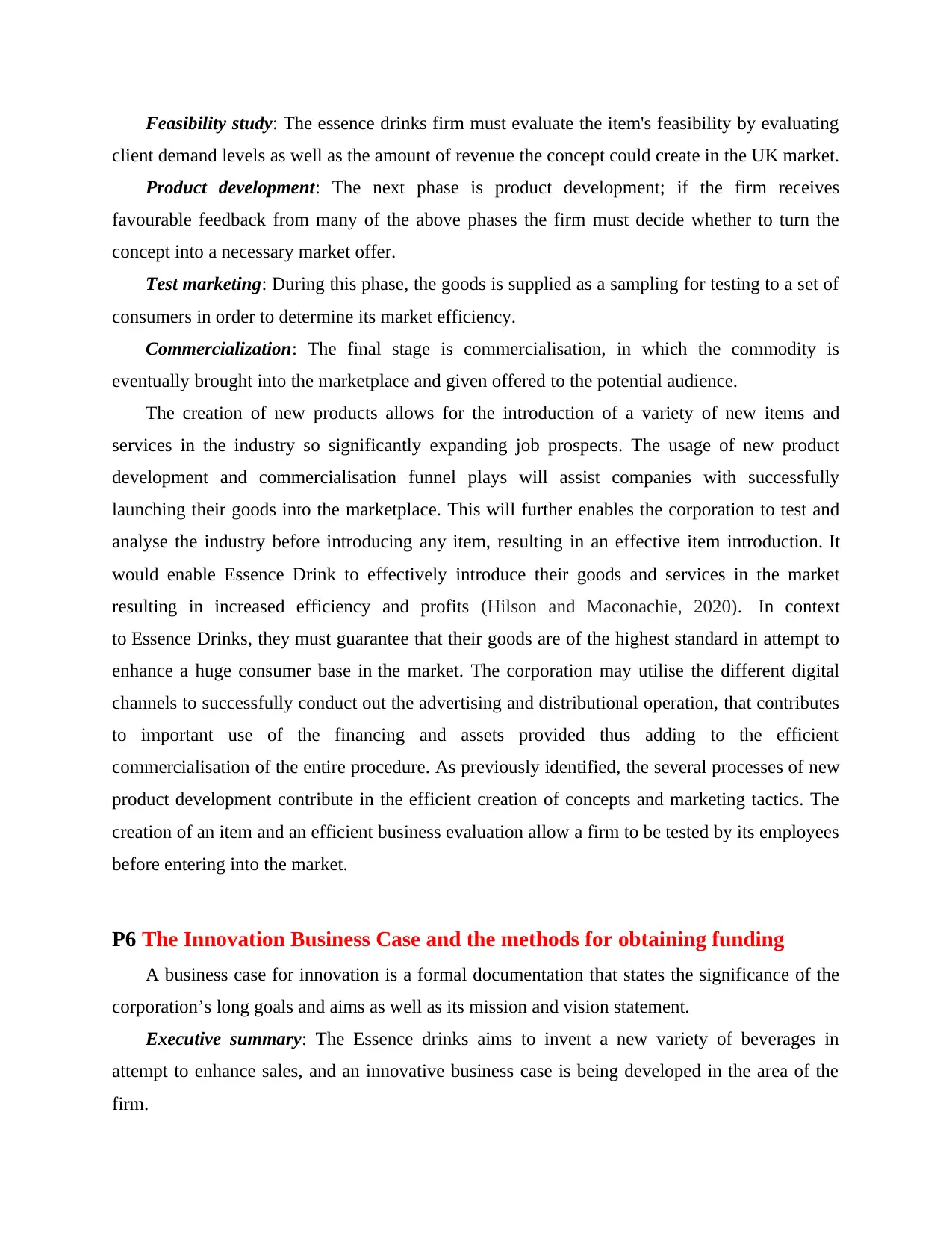
Feasibility study: The essence drinks firm must evaluate the item's feasibility by evaluating
client demand levels as well as the amount of revenue the concept could create in the UK market.
Product development: The next phase is product development; if the firm receives
favourable feedback from many of the above phases the firm must decide whether to turn the
concept into a necessary market offer.
Test marketing: During this phase, the goods is supplied as a sampling for testing to a set of
consumers in order to determine its market efficiency.
Commercialization: The final stage is commercialisation, in which the commodity is
eventually brought into the marketplace and given offered to the potential audience.
The creation of new products allows for the introduction of a variety of new items and
services in the industry so significantly expanding job prospects. The usage of new product
development and commercialisation funnel plays will assist companies with successfully
launching their goods into the marketplace. This will further enables the corporation to test and
analyse the industry before introducing any item, resulting in an effective item introduction. It
would enable Essence Drink to effectively introduce their goods and services in the market
resulting in increased efficiency and profits (Hilson and Maconachie, 2020). In context
to Essence Drinks, they must guarantee that their goods are of the highest standard in attempt to
enhance a huge consumer base in the market. The corporation may utilise the different digital
channels to successfully conduct out the advertising and distributional operation, that contributes
to important use of the financing and assets provided thus adding to the efficient
commercialisation of the entire procedure. As previously identified, the several processes of new
product development contribute in the efficient creation of concepts and marketing tactics. The
creation of an item and an efficient business evaluation allow a firm to be tested by its employees
before entering into the market.
P6 The Innovation Business Case and the methods for obtaining funding
A business case for innovation is a formal documentation that states the significance of the
corporation’s long goals and aims as well as its mission and vision statement.
Executive summary: The Essence drinks aims to invent a new variety of beverages in
attempt to enhance sales, and an innovative business case is being developed in the area of the
firm.
client demand levels as well as the amount of revenue the concept could create in the UK market.
Product development: The next phase is product development; if the firm receives
favourable feedback from many of the above phases the firm must decide whether to turn the
concept into a necessary market offer.
Test marketing: During this phase, the goods is supplied as a sampling for testing to a set of
consumers in order to determine its market efficiency.
Commercialization: The final stage is commercialisation, in which the commodity is
eventually brought into the marketplace and given offered to the potential audience.
The creation of new products allows for the introduction of a variety of new items and
services in the industry so significantly expanding job prospects. The usage of new product
development and commercialisation funnel plays will assist companies with successfully
launching their goods into the marketplace. This will further enables the corporation to test and
analyse the industry before introducing any item, resulting in an effective item introduction. It
would enable Essence Drink to effectively introduce their goods and services in the market
resulting in increased efficiency and profits (Hilson and Maconachie, 2020). In context
to Essence Drinks, they must guarantee that their goods are of the highest standard in attempt to
enhance a huge consumer base in the market. The corporation may utilise the different digital
channels to successfully conduct out the advertising and distributional operation, that contributes
to important use of the financing and assets provided thus adding to the efficient
commercialisation of the entire procedure. As previously identified, the several processes of new
product development contribute in the efficient creation of concepts and marketing tactics. The
creation of an item and an efficient business evaluation allow a firm to be tested by its employees
before entering into the market.
P6 The Innovation Business Case and the methods for obtaining funding
A business case for innovation is a formal documentation that states the significance of the
corporation’s long goals and aims as well as its mission and vision statement.
Executive summary: The Essence drinks aims to invent a new variety of beverages in
attempt to enhance sales, and an innovative business case is being developed in the area of the
firm.
Paraphrase This Document
Need a fresh take? Get an instant paraphrase of this document with our AI Paraphraser
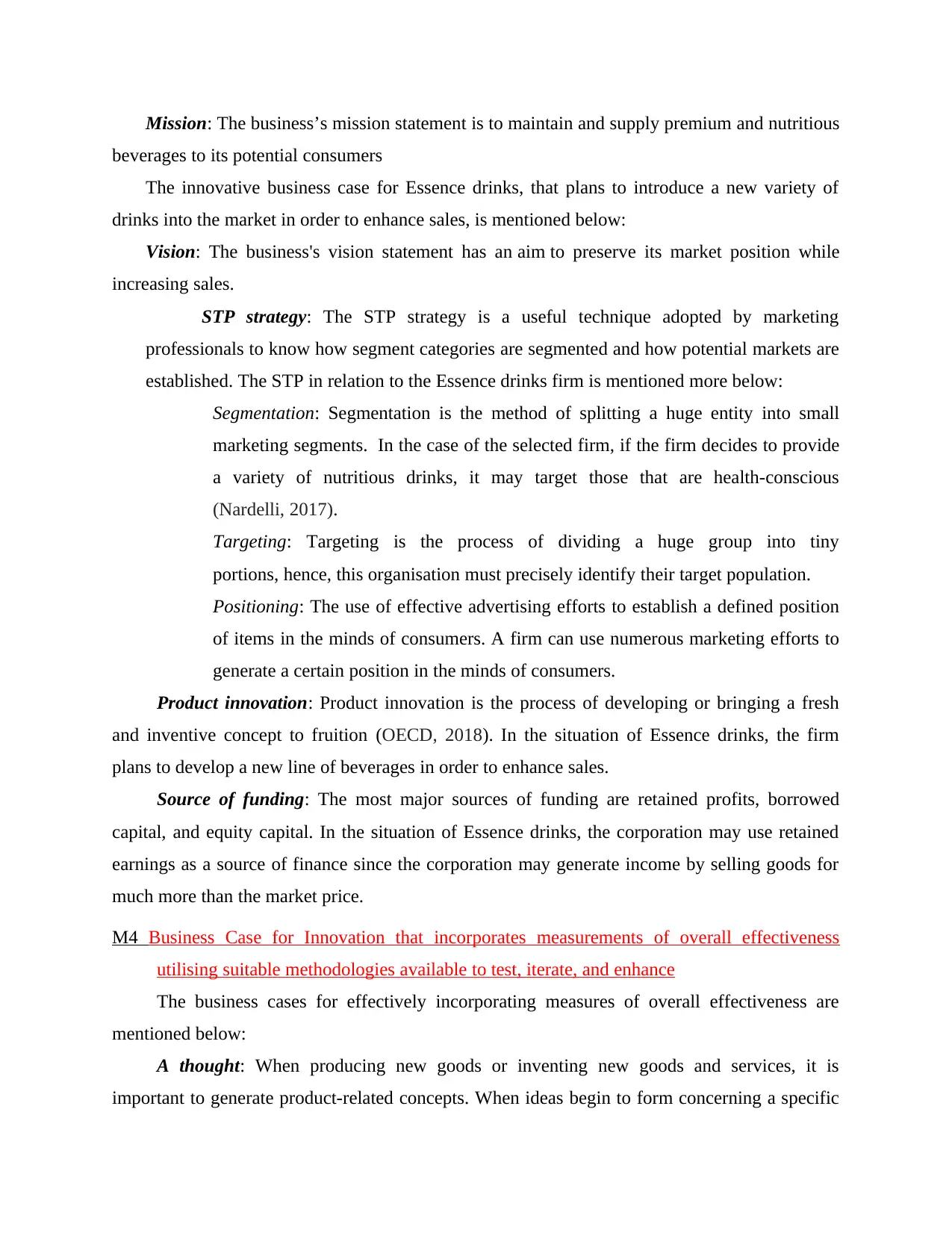
Mission: The business’s mission statement is to maintain and supply premium and nutritious
beverages to its potential consumers
The innovative business case for Essence drinks, that plans to introduce a new variety of
drinks into the market in order to enhance sales, is mentioned below:
Vision: The business's vision statement has an aim to preserve its market position while
increasing sales.
STP strategy: The STP strategy is a useful technique adopted by marketing
professionals to know how segment categories are segmented and how potential markets are
established. The STP in relation to the Essence drinks firm is mentioned more below:
Segmentation: Segmentation is the method of splitting a huge entity into small
marketing segments. In the case of the selected firm, if the firm decides to provide
a variety of nutritious drinks, it may target those that are health-conscious
(Nardelli, 2017).
Targeting: Targeting is the process of dividing a huge group into tiny
portions, hence, this organisation must precisely identify their target population.
Positioning: The use of effective advertising efforts to establish a defined position
of items in the minds of consumers. A firm can use numerous marketing efforts to
generate a certain position in the minds of consumers.
Product innovation: Product innovation is the process of developing or bringing a fresh
and inventive concept to fruition (OECD, 2018). In the situation of Essence drinks, the firm
plans to develop a new line of beverages in order to enhance sales.
Source of funding: The most major sources of funding are retained profits, borrowed
capital, and equity capital. In the situation of Essence drinks, the corporation may use retained
earnings as a source of finance since the corporation may generate income by selling goods for
much more than the market price.
M4 Business Case for Innovation that incorporates measurements of overall effectiveness
utilising suitable methodologies available to test, iterate, and enhance
The business cases for effectively incorporating measures of overall effectiveness are
mentioned below:
A thought: When producing new goods or inventing new goods and services, it is
important to generate product-related concepts. When ideas begin to form concerning a specific
beverages to its potential consumers
The innovative business case for Essence drinks, that plans to introduce a new variety of
drinks into the market in order to enhance sales, is mentioned below:
Vision: The business's vision statement has an aim to preserve its market position while
increasing sales.
STP strategy: The STP strategy is a useful technique adopted by marketing
professionals to know how segment categories are segmented and how potential markets are
established. The STP in relation to the Essence drinks firm is mentioned more below:
Segmentation: Segmentation is the method of splitting a huge entity into small
marketing segments. In the case of the selected firm, if the firm decides to provide
a variety of nutritious drinks, it may target those that are health-conscious
(Nardelli, 2017).
Targeting: Targeting is the process of dividing a huge group into tiny
portions, hence, this organisation must precisely identify their target population.
Positioning: The use of effective advertising efforts to establish a defined position
of items in the minds of consumers. A firm can use numerous marketing efforts to
generate a certain position in the minds of consumers.
Product innovation: Product innovation is the process of developing or bringing a fresh
and inventive concept to fruition (OECD, 2018). In the situation of Essence drinks, the firm
plans to develop a new line of beverages in order to enhance sales.
Source of funding: The most major sources of funding are retained profits, borrowed
capital, and equity capital. In the situation of Essence drinks, the corporation may use retained
earnings as a source of finance since the corporation may generate income by selling goods for
much more than the market price.
M4 Business Case for Innovation that incorporates measurements of overall effectiveness
utilising suitable methodologies available to test, iterate, and enhance
The business cases for effectively incorporating measures of overall effectiveness are
mentioned below:
A thought: When producing new goods or inventing new goods and services, it is
important to generate product-related concepts. When ideas begin to form concerning a specific
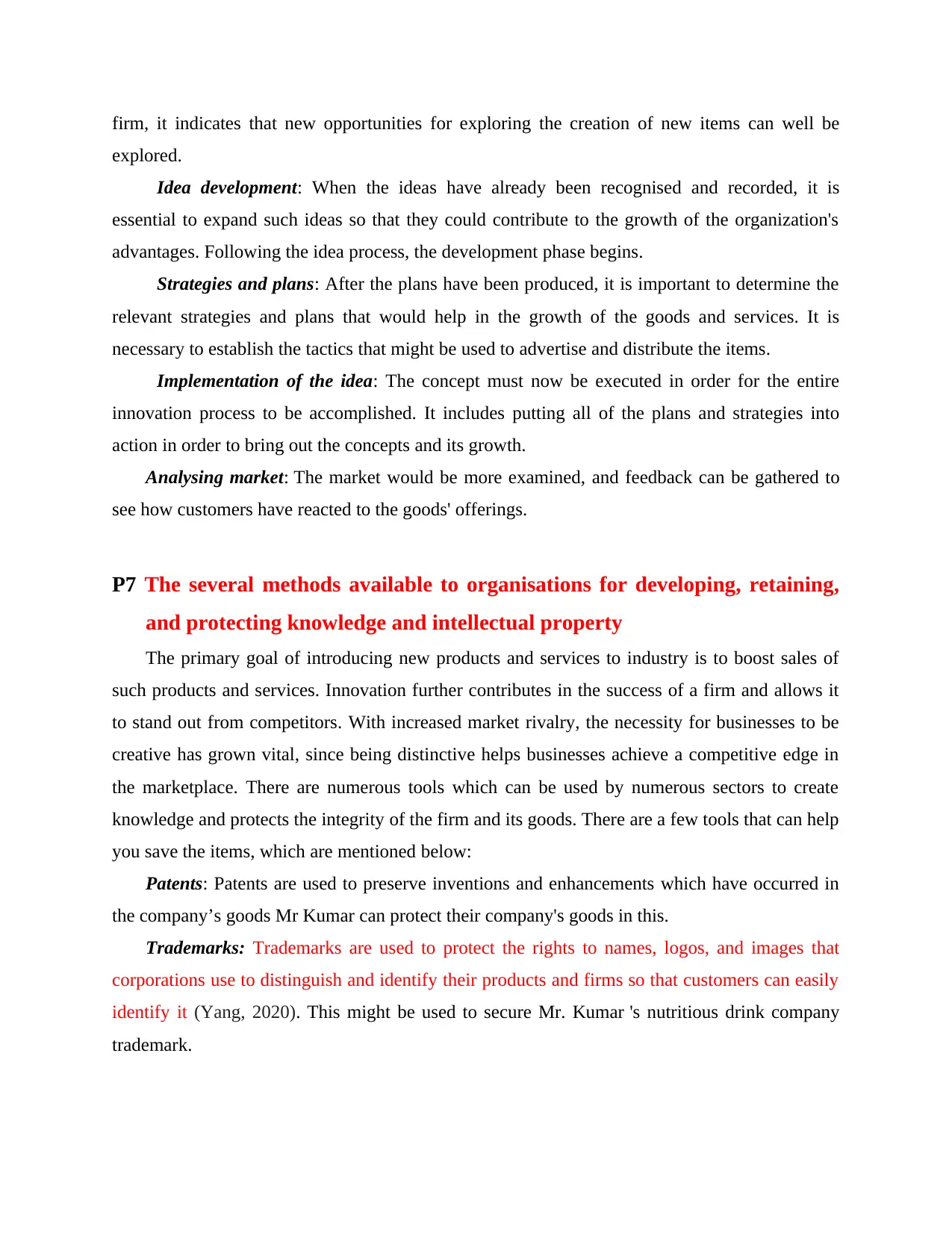
firm, it indicates that new opportunities for exploring the creation of new items can well be
explored.
Idea development: When the ideas have already been recognised and recorded, it is
essential to expand such ideas so that they could contribute to the growth of the organization's
advantages. Following the idea process, the development phase begins.
Strategies and plans: After the plans have been produced, it is important to determine the
relevant strategies and plans that would help in the growth of the goods and services. It is
necessary to establish the tactics that might be used to advertise and distribute the items.
Implementation of the idea: The concept must now be executed in order for the entire
innovation process to be accomplished. It includes putting all of the plans and strategies into
action in order to bring out the concepts and its growth.
Analysing market: The market would be more examined, and feedback can be gathered to
see how customers have reacted to the goods' offerings.
P7 The several methods available to organisations for developing, retaining,
and protecting knowledge and intellectual property
The primary goal of introducing new products and services to industry is to boost sales of
such products and services. Innovation further contributes in the success of a firm and allows it
to stand out from competitors. With increased market rivalry, the necessity for businesses to be
creative has grown vital, since being distinctive helps businesses achieve a competitive edge in
the marketplace. There are numerous tools which can be used by numerous sectors to create
knowledge and protects the integrity of the firm and its goods. There are a few tools that can help
you save the items, which are mentioned below:
Patents: Patents are used to preserve inventions and enhancements which have occurred in
the company’s goods Mr Kumar can protect their company's goods in this.
Trademarks: Trademarks are used to protect the rights to names, logos, and images that
corporations use to distinguish and identify their products and firms so that customers can easily
identify it (Yang, 2020). This might be used to secure Mr. Kumar 's nutritious drink company
trademark.
explored.
Idea development: When the ideas have already been recognised and recorded, it is
essential to expand such ideas so that they could contribute to the growth of the organization's
advantages. Following the idea process, the development phase begins.
Strategies and plans: After the plans have been produced, it is important to determine the
relevant strategies and plans that would help in the growth of the goods and services. It is
necessary to establish the tactics that might be used to advertise and distribute the items.
Implementation of the idea: The concept must now be executed in order for the entire
innovation process to be accomplished. It includes putting all of the plans and strategies into
action in order to bring out the concepts and its growth.
Analysing market: The market would be more examined, and feedback can be gathered to
see how customers have reacted to the goods' offerings.
P7 The several methods available to organisations for developing, retaining,
and protecting knowledge and intellectual property
The primary goal of introducing new products and services to industry is to boost sales of
such products and services. Innovation further contributes in the success of a firm and allows it
to stand out from competitors. With increased market rivalry, the necessity for businesses to be
creative has grown vital, since being distinctive helps businesses achieve a competitive edge in
the marketplace. There are numerous tools which can be used by numerous sectors to create
knowledge and protects the integrity of the firm and its goods. There are a few tools that can help
you save the items, which are mentioned below:
Patents: Patents are used to preserve inventions and enhancements which have occurred in
the company’s goods Mr Kumar can protect their company's goods in this.
Trademarks: Trademarks are used to protect the rights to names, logos, and images that
corporations use to distinguish and identify their products and firms so that customers can easily
identify it (Yang, 2020). This might be used to secure Mr. Kumar 's nutritious drink company
trademark.
⊘ This is a preview!⊘
Do you want full access?
Subscribe today to unlock all pages.

Trusted by 1+ million students worldwide
1 out of 15
Related Documents
Your All-in-One AI-Powered Toolkit for Academic Success.
+13062052269
info@desklib.com
Available 24*7 on WhatsApp / Email
![[object Object]](/_next/static/media/star-bottom.7253800d.svg)
Unlock your academic potential
Copyright © 2020–2025 A2Z Services. All Rights Reserved. Developed and managed by ZUCOL.



